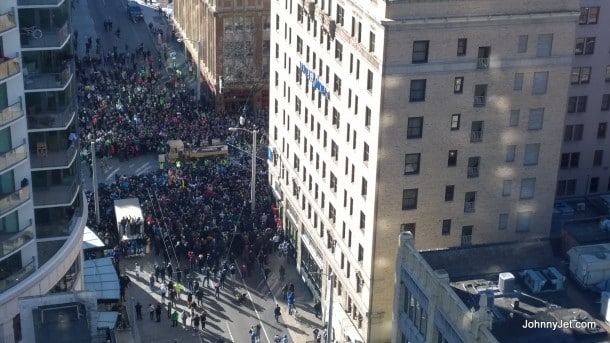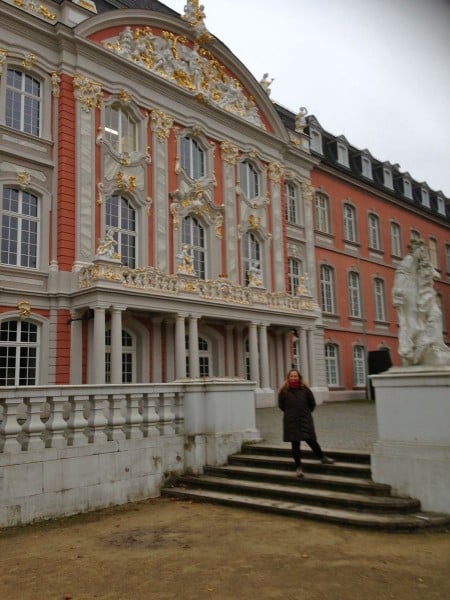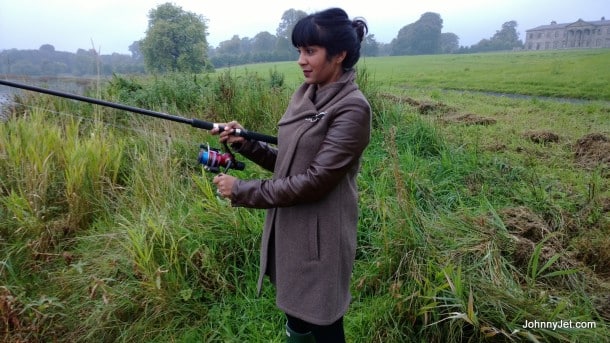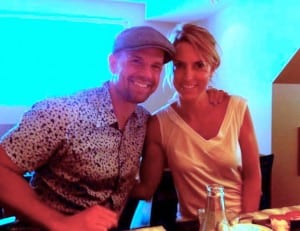
Fireworks… Subway system by Jackson Pollock… Monkeys make most sense as pets… Cats are very good luck… Udon, Sushi, BBQ, tempura, yes please… No garbage cans anywhere = No garbage anywhere… PRAY often… Toilets talk to you, this is not God… Bad fortune is Good fortune, you learn more and grow more… Life is one big Manga/Anime… No matter what you choose to do, do it with respect of those before you and after you… Harajuku girls have got all the style… Love you Tokyo! Thank you… xoxo – Peter Gibson
This is how my boyfriend summed up our three days in Tokyo on our stopover to Thailand. Feeling often like aliens in a strange new planet, we loved learning and being part of the Japanese culture, around 20 years later for both of us.
Peter modeled and lived in Roppongi in 1991 for six months and I mad dashed through Kobe, Kyoto, and Nara in 1994 on Semester at Sea. The present day 2012 Tokyo felt maddening to me, like 20 New York Cities packed into one giant swarming swirling mass of transportation systems and temples entwined with dark haired fast moving quiet people. Perhaps it was the humidity and almost 100 degree temperatures, but my patience and endurance started to tank after day one. Thank God my boyfriend could navigate the metro system with its 100 of colors in a language we could only try to pronounce – Marunouchi Line, Yarakucho Line, Fukutoshin Line, Hibaya Line, and more. After not sleeping for over 24 hours we walked for more than 10 hours not wanting to miss a thing.
Make the most of Tokyo by experiencing the following:
1. Peruse the Tsukiji Fish market
Go early when the action takes place. The world’s sushi comes from this hub and oh what a squirming often bloody mess it can be! Mini
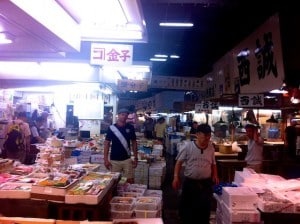
trucks transporting the leftover fish parts, tables with eyes staring back at you, and men slashing and knocking out the fish as they cut their necks and put wire through the bodies and packed them on ice.
We saw just about every imaginable ocean creature, many I had never seen before in my life. There are more than 400 different kids of seafood that arrive for auctioning and dispatching at Tsukiji. Eels come from Taiwan, shrimp from Thailand, salmon from Chile and Canada, and tuna from Tasmania. Nearby are a bunch of small shops that sell knives, kitchen utensils, crockery, and bamboo goods. Also, we stumbled upon an intimate temple nearby on our way into the Fish Market.
2. Explore one of the many temples nestled into the city, such as:
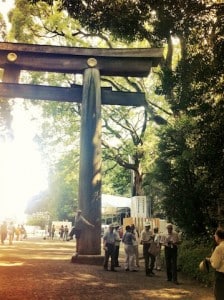
Meiji Shrine (near Harajuku) – The 36-foot gate or Torii (Japan’s largest torii) made from 1,600 year old Japanese hinoki cypress trees from Alishan Mountain in Taiwan leads you to the classic Shinto style shrine. As you walk some distance, you pass about a 100 large empty saki caskets, which were donated by various brewers over the years.
Before entering the shrine, you can wash your hands and face like the locals with the sacred water fountain in a beautifully crafted wooden table. Meiji Shrine is dedicated to the memory of the Meiji Emperor (1868-1912) and his consort Shoken. Meiji was the 122nd Emperor of Japan and was responsible for helping aide the transition in Japan from a feudal shogunate to a great world power, through political, social, and industrial changes.
Entering the wide expanse you will see Ema or votive tablets to your right, which are still popular today. Some are hung in gratitude when a wish is fulfilled while others are asking for divine help. The Imperial Treasure House holds a collection of personal artifacts that belong to the Meiji royalty. Much of the shrine grounds are densely forested so that this refuge feels peaceful from the maddening city just steps away.
Senso-Ji Temple – Located near the area called Asakusa, we popped off the subway to find rows and rows of neat stalls of Japanese souvenirs and gifts on our way to this impressive temple we saw in the skyline.
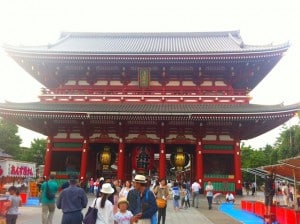
Nakimase or the main avenue is crammed with booths selling a wide range of traditional goods. Cats are good luck here, so you will see them on many items. Who can forget the highly popular Monchichi doll that Mattel brought to America in 1979? Everyone I knew growing up had one. Monchichi dolls can be purchased as well as just about anything you can imagine with Hello Kitty on it, which was another American craze that was brought to the US around 1976 and still today is popular with young children and some adults. Hello Kitty was designed by a Japanese woman named Yuko Shimizu and produced by the Japanese company Sanrio. I find it funny the Kitty has no mouth. I left with adorable Hello Kitty Japanese style slippers.
Senso-ji Temple was very crowded when we were there. It is the oldest temple site in Tokyo. Thousands of visitors come here to pray inside the main hall with its opulent, golden alter and priceless collection of 18th- and 19th- century votive paintings. Highlights of this temple area include the Main Hall, the Thunder Gate flanked by two gods with a red paper lantern with the character for “thunder” written across it that hangs above the gate, the giant bronze incense burner that stands in front of the Main Hall where the faithful waft smoke over their clothes for good luck, the Nade Jizo or bronze bodhisattva statue symbolizing a figure of compassion which is believed to relieve ailments if you rub the part of the body that troubles you, and the Denbo-in Garden designed in the early 1600s by the Zen gardener Kobori Enshu, where tea ceremonies are performed in a small pavilion beside the pond.
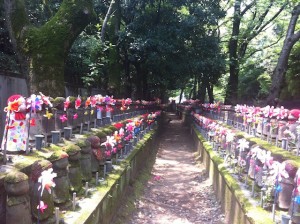
Zojo-ji Temple (near Tokyo Tower) – Since most of these temples have been reconstructed due to the WWII air raids, this temple was reconstructed in the 1970’s. The original temple was founded in 1393 and removed to the present location in 1598 by Tokugawa Ieyasu who selected it as his family temple. A mausoleum of the Tokugawa family can be found on the temple grounds. Many religious events are held here and the main hall contains ancient statues, sutras, and other sacred objects.
The Tokyo Tower lies behind the temple and reminded me of a version of the Eiffel Tower. Before entering on the left we saw a sign that said, “This tree was planted by the forty first president GEORGE H*W* BUSH of the United States in memory of his visit to Zojoji temple in 1982 when he was vice president.”
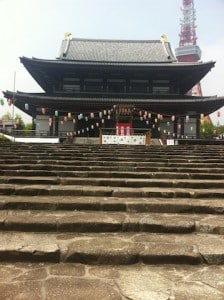
What I found most fascinating about this temple was not only the eerie quiet but the rows and rows of child-like miniature statues in the garden – some with outfits and bonnets on – that held little pinwheels. The pinwheels were continually whirring making a sound to say almost that we are still alive. The black crows were flying and landing on many of the little stone children statues.
I later learned that these were statues of jizobosatusu, the protector of the souls of stillborn children and the Buddhist equivalent of an angel. Mothers who have lost an unborn child may dedicate an image of the deity and decorate it with baby clothes and toys. Inside the temple is a beautifully decorated golden alter where we watched and listened as many monks and a priest chanted and prayed.
We met a kind man with his young daughter who told us about the special prayers and wishes that we could find here. Afterwards, they joined us behind the temple as we shot up the Tokyo Tower for city views. The daughter practiced her English on us and had to translate most of our conversation to her father. They took us to a great udon tempura restaurant too where they ordered just about everything for us to try. I see them now as we waved goodbye to them in the subway station – a moment in time that can never be replaced. Kindness.
3. Walk the area known as Harajuku for some pop culture flavor Japanese-style.
Stride the buzzing hip street Takeshita-Dora where I’m sure Gwen Stefani’s song “Harajuku Girls” will be buzzing through your head the whole time as you see the girls ‘with the latest style’ – more like dressed up dolls on high platformed shoes, bows, and funky long braided hair. Even the Goth rock Harajuku style look is popular. This crazy street filled with funky boutiques, kitschy accessories, costumery, and cutesy junk is just fun to people watch. The Japanese youth will surely entertain you.
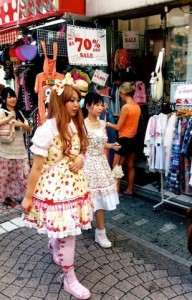
Around this area we saw one of the neatest candy stores ever! A giant piece of pillow candy (the size of pillow) was rolled nonstop by three girls as it shrank down to minuscule long skinny rolls that were sliced after hardening (like giant taffy) and each piece came with a message inside – truly remarkable! Check out a video of the store Candy Show Time.
Also, there was a tiny shop that sold French toast bites with a menu filled with different toppings. We also came back another day and enjoyed delicious neatly packaged crepes as we headed out to nearby Meiji Shrine. I bought a cute pink ruffly dress with off white netting on the top for about $10 on the street. My major suggestion is bring yen because not one ATM machine anywhere would accept our debit cards, which we found quite frustrating since most stores did not take credit card in this area. Also, it is impossible to figure out or read their ATM machines too since there is no English translation version. I guess they aren’t use to Americans coming over who want to spend money.
4. Try new foods and head to the local restaurants.
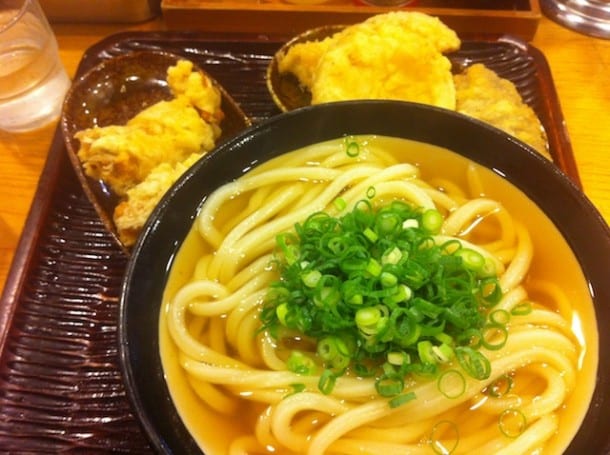
Some of our best meals were where the locals took us for udon and tempura. I don’t think you can go wrong anywhere in Japan with the sushi. The $50 lunch outside of Harajuku on Omotesandō in the bottom of the Anna Sui store looked just as good as the sushi I saw on the way up to the Sky Tower for about $10.
Tip: Remember in Japan when you slurp your noodles loud, it means you like the food. It is polite.
I had to laugh as we were crammed together with the Japanese eating our udon and we couldn’t even figure out how to use the condiments on the table. Napkins are a rarity. They are not out for you to take, like at most US fast food joints. However, water is often provided on the tables. There are so many different snacks and meals to try in Tokyo. We ate this cake-like thing on a stick that tasted like pound cake. We saw a Whale Meat restaurant, but shied away from what was suppose to be one of the best restaurants for Organic Sushi since it looked like the fish was ten years old. I would definitely recommend sampling many different new foods at the brand new Tokyo Skytree, the tallest structure in Japan and the tallest tower in the world.
5. Head on up to the Tokyo Skytree, the largest tower in the world or the Tokyo Tower (Eiffel Tower clone)
The Tokyo Tower was built in 1958 and known for the 2007 film of the same name. Impressive views can be seen by both towers.
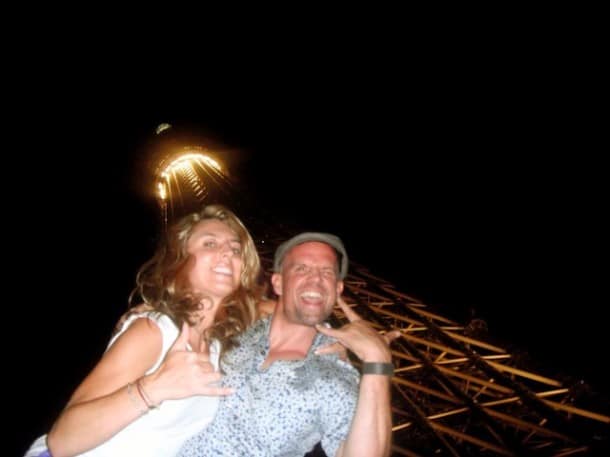
However, it was quite grey and overcast when we were at the Tokyo Tower, so it was hard to see far.
One of our memorable moments was leaving the Tokyo Tower, due to our fascination with monkeys. Not that we condone it, but Sakura, a monkey was dressed up and performing outrageous acts outside. We were in awe of his impressive feats and human-like qualities as he soared over tables and ripped his monkey top off.
The newer Tokyo Skytree is quite impressive and is a long way up, but the crowds are nuts. The food choices and different options excited me on several levels on the way up. At night we viewed the dizzying maze of lights from 2,080 feet and I was ready to come down as one section allowed you to see through glass to the bottom city streets.

Other Tokyo Tips:
Catch a Baseball game at the Tokyo Dome, view a traditional Japanese tea ceremony, enjoy a Noh play or the Kabuki theater, walk around the Imperial Palace Grounds, Ueno Park, the oldest garden (Koishikawa Korakuen Garden) or the Yanaka cemetery. Explore the artificial Odaiba Island or trace the history of the city from Edo Castle to the Tokyo Olympics at the Edo-Tokyo Museum, then learn about more Japanese treasures at the Tokyo National Museum.
Tip: Check the weather. It was oppressively hot and humid in August, so dressing comfortable and airy light is advised.


